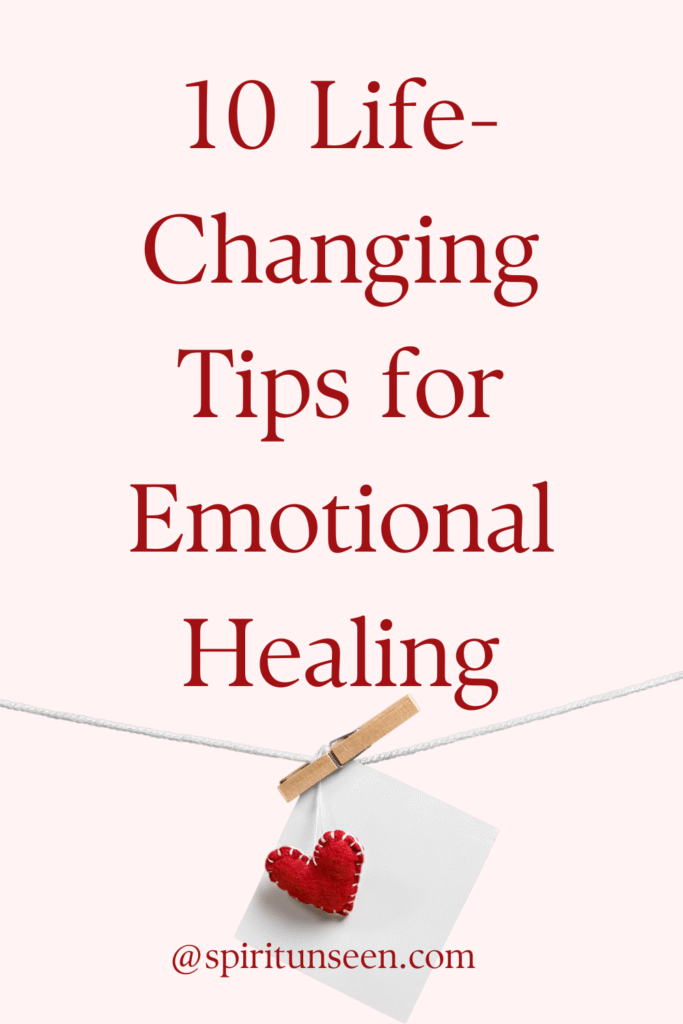
f you’ve ever gone through something that left you feeling broken, disappointed, or unworthy, chances are you’re still carrying emotional wounds. These might stem from the loss of a loved one, a painful breakup, illness, or another challenging life event. You may think you’ve hidden these emotions well—but repressed feelings tend to show up in everyday life, whether we notice them or not.
In today’s article, you’ll learn why emotional healing is so essential, the stages involved in this healing process, and how to recognize if you’re healing. Finally, we’ll explore ten practical techniques to help you begin the journey of emotional healing and recovery.
Why is emotional healing important?
Have you ever come across a cashier who seems like they’re seething with anger? Or maybe a co-worker who always carries a cloud of sadness? Perhaps you’ve kept your ideas to yourself out of fear others might dismiss them?
All of these reactions are rooted in unresolved emotional pain. Whether you realize it or not, past emotional scars can continue to block your personal growth and happiness. Unless you know how to identify and address these wounds, they can hold you back in ways you might not even see.
Women often mask emotional distress through moodiness, withdrawal, or defensiveness. Men may channel their pain into excessive toughness, irritability, or ego.
Sometimes it looks like arrogance or avoiding close relationships to avoid potential pain. Regardless of how it appears, unresolved emotions can keep you stuck in unhelpful patterns.
The good news? Emotional wounds can be healed. With time, patience, and proper emotional healing tools, you can let go of old pain and move toward inner peace. While it won’t happen overnight, emotional healing is entirely possible.
The 5 stages of emotional healing

Emotional healing is a process, and while it’s different for everyone, it often unfolds in five key stages:
1. Suffering – You deny your emotions or dismiss your pain. 2. Awareness – You begin to acknowledge your feelings and understand where they’re coming from. 3. Confrontation – You stop running from pain and begin facing it head-on. 4. Expression – You allow yourself to release emotions through crying, yelling, writing, or another outlet. 5. Acceptance – You come to terms with the past and start seeking healthy ways to move forward.
Signs that you are emotionally healing

The signs of emotional healing are subtle at first, but they become clear over time. Here are some key indicators:
- You start thinking more positively and feel inspired about the future.
- You begin prioritizing your well-being with nutritious food, physical activity, and better sleep.
- You become more courageous, stepping out of your comfort zone.
- Your energy levels rise, and your mood improves.
- You recognize that emotional lows are temporary and accept them without judgment.
- You begin creating a life you’re excited about and feel capable of achieving your goals.
How long emotional healing takes
There’s no universal timeline for emotional healing. It depends on factors like the intensity of your trauma, the support you have, your personal resilience, and how much time and energy you dedicate to healing.
Healing emotionally requires patience, kindness toward yourself, and sometimes the guidance of a trained professional. Just remember—healing is a process unique to each person.
10 techniques to heal emotional wounds

Here are 10 daily habits and strategies that can help support your emotional healing journey:
1. Express what you’re feeling
Find constructive outlets for your emotions. Talk to a loved one, make art, dance, or write. Journaling is especially useful—it gives you a safe space to process emotions and understand yourself better.
💡 Need help getting started? Try a healing journal with guided prompts to help explore your feelings and work through past pain.
2. Show yourself compassion
Speak kindly to yourself. Instead of criticizing your mistakes or negative emotions, approach them with gentleness. Tell yourself it’s okay to struggle. You deserve patience and understanding.
3. Practice daily self-care
Set aside time each day to do something that brings you peace and happiness. Whether it’s a walk, a hot bath, listening to calming music, or baking—choose activities that refill your emotional tank.
4. Create healthy boundaries
Knowing and protecting your emotional limits is essential. Practice saying “no” when necessary, and don’t be afraid to distance yourself from relationships or environments that feel draining.
5. Choose to forgive
Forgiveness doesn’t mean excusing harm, but it allows you to let go of resentment. Releasing bitterness lightens your emotional load and frees you to move forward.
6. Ask for support
Don’t go through healing alone. Lean on trusted friends or seek a therapist who can offer perspective, tools, and a safe space to talk. Being heard and supported makes a big difference.
7. Practice gratitude
Focus on the blessings in your life, even the small ones. Keep a gratitude list or journal to remind yourself of what’s going right. This shift in perspective can help brighten even the darkest days.
8. Make time for self-reflection
Spend a few quiet minutes each day checking in with yourself. Reflect on your thoughts and feelings, and notice how they’ve changed. This helps you become more self-aware and identify where healing is still needed.
9. Use affirmations
Positive affirmations help rewire negative beliefs. Speak healing statements like “I am allowed to feel and grow” or “I am healing more every day.” Repeating these phrases daily reinforces emotional strength and self-worth.
10. Be patient and allow the process
Emotional healing isn’t instant. It includes ups and downs. Be patient with setbacks and celebrate small victories. Trust that progress is happening, even if it feels slow.
Final Thoughts
Emotional healing looks different for everyone. Explore these practices and find what resonates most with you. If things feel overwhelming, it’s always okay to seek guidance from a therapist or counselor.
By taking small steps each day, you can let go of what no longer serves you and create space for peace, purpose, and emotional clarity.
